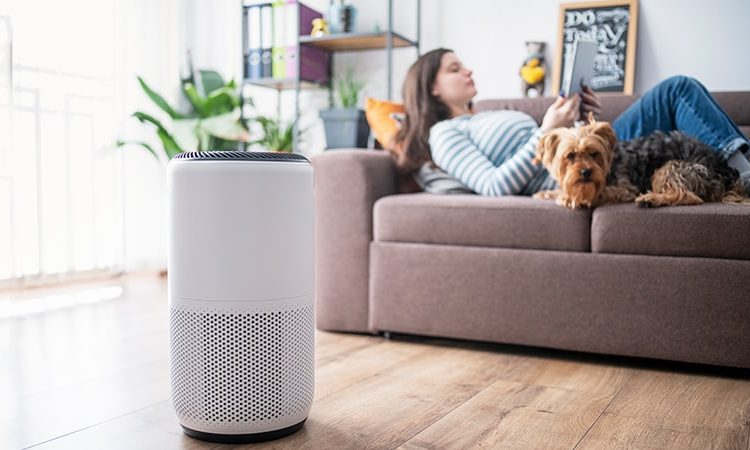Portable home high‐efficiency particulate air (HEPA) filters effectively and inexpensively clear indoor air of particles and dust mite, cat, and dog aeroallergens, an industry-sponsored study conducted in Germany reports.

Dr Jeroen Buters
“We were surprised how efficient air filtration was and how fast a bedroom was cleaned from all major allergens,” senior study author Jeroen Buters, PhD, a toxicologist at the Center of Allergy and Environment of the Technical University of Munich, in Germany, told Medscape Medical News. “We were also surprised to find high quantities of cat and dog allergens in homes with no dog or cat.
“Air filtration is easy and works exactly on what makes patients ill: inhaling airborne allergens,” he added in an email. “Allergens are particles or they stick to airborne particles. If you remove particles, you should remove allergens, and reducing allergen exposure reduces allergy symptoms.”
A Novel, Real-Life Study in People’s Homes
Buters explained that previous studies of the devices had been conducted in laboratories and that his research team took a novel approach by testing how well they work in people’s homes.
As reported in Clinical and Translational Allergy, Buters and his colleagues set up an air purifier (Philips Air Purifier AC4236, 4000i series) with a HEPA filter. The clean air delivery rate was 500 m3/h in one bedroom of each of 22 homes near Munich.
Participants were adults whose bedrooms were on the ground floor. A door separate the bedrooms from other rooms. The participants preferred to sleep with the windows closed during the winter. Mattresses in participant bedrooms were more than 4 years old. Participants agreed not change their bedding for 2 weeks before each of two home visits and to not travel for more than 1 week during the study. Among the households excluded were those with high ceilings, bunk beds or waterbeds, recently vacuumed mattresses, dehumidifiers, use of products to kill dust mites, and household members with asthma.
The randomized crossover study took place over 24 weeks between February and April 2020. (It was put on pause between April and June because of COVID-19 lockdown in Germany.) A control visit and an intervention visit were held 4 weeks or less apart.
Air flow was permanently monitored by an in-line gas flow meter, and during each visit, researchers collected samples of airborne particles with a cascade impactor connected to a pump. They measured allergens using enzyme‐linked immunosorbent assay (ELISA), and they monitored particulate matter (PM), including ultrafine particles.
In half the bedrooms, the first readings (control) were taken without air filtration during sampling, and the second readings (intervention) were taken with air filtration; in the remaining bedrooms, the order was reversed.
Clearing the Air
The median decrease in allergens Der f 1 from the house mite Dermatophagoides farinae was 75.2% (P < .001, n = 20); 65.5% for Der p 1 from Dermatophagoides pteronyssinus (P = .066, n = 4), possibly owing to the low number of houses in which it was found; 76.6% for Fel d 1 cat allergen (P < .01, n = 21); and 89.3% for Can f 1 dog allergen (P < .01, n = 10).
Size fraction reductions were statistically significant for Der f 1 (all P < .001), Can f 1 (PM >10 μm and PM2.5–10 μm, P < .01), and Fel d 1 (PM2.5–10 μm, P < .01), but not for Der p 1 (all P > .05).
PM in all fractions decreased (P < .001). Allergens were detected in all particle size fractions, including higher mite allergens with PM >10 μm and pet allergens with PM2.5–10 μm.
Although this study did not assess participants’ health, Buters said that removing allergens from the air should make people with allergies feel better.

Dr Michael Kohanski
“The decrease in fine particle and airborne allergen concentrations with air purifier use at a high flow rate makes sense,” said Michael A. Kohanski, MD, PhD, assistant professor in the Department of Otorhinolaryngology, Head and Neck Surgery, at the Perelman School of Medicine of the University of Pennsylvania in Philadelphia. “It was interesting to see how effective an air purifier was at removing PM1 and PM2.5, which typically remain airborne for a long time after a dust disturbance.
“This study optimized conditions to detect airborne house dust mite,” Kohanski, who was not involved in the study, added in an email. “It is unclear if air purifier use in general significantly reduces house dust mite allergen exposure in combination with standard reduction methods (frequent washing of bedding, cleaning of surfaces and floors, dust covers for pillows and mattresses).”

Dr Merritt Fajt
Merritt L. Fajt, MD, FAAAAI, an assistant professor of medicine in the Division of Pulmonary, Allergy and Critical Care Medicine at the University of Pittsburgh School of Medicine in Pennsylvania, called this study very important.
“For people sensitive to dust mite, cat, or dog, this relatively simple home intervention may help eliminate some allergen exposure and symptoms,” she said.
“Interestingly, although only three homes had a pet cat, the authors found cat allergen in 21 homes; and although only two homes had a dog, the authors found dog allergen in ten homes,” noted Fajt, who also was not involved in the study. “We can’t underestimate how prevalent these allergens are, even in homes without pets.
“Although this is a small study, the authors showed impressive decreases in the levels of these allergens in the home by running the portable air purifier. When patients ask their doctors if they should have an air purifier in their home, we can tell them, ‘Yes.’ “
One co-author is employed by Philips. This study was sponsored by Philips Inc., which provided the air filtration devices and the ultrafine particle tracer. Open access funding was supported by Projekt DEAL. Kohanski and Fajt report no relevant financial relationships.
Clin Transl Allergy. Published online April 21, 2022. Full text
For more news, follow Medscape on Facebook, Twitter, Instagram, and YouTube.
Source: Read Full Article
